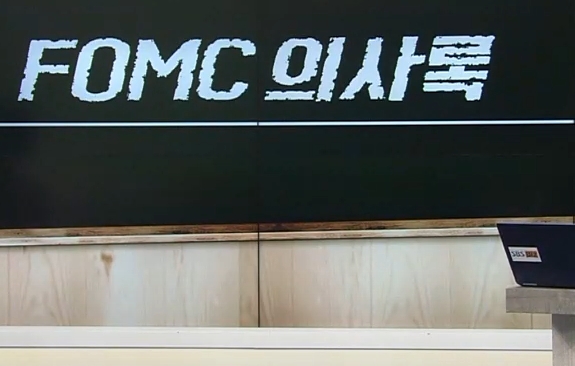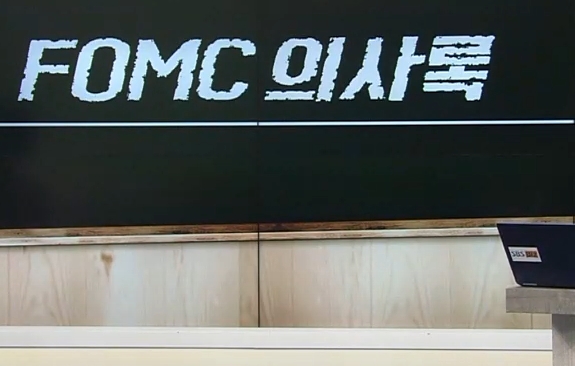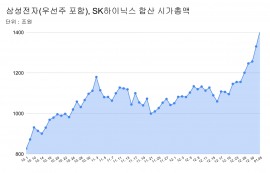연준 의사록Minutes of the Federal Open Market Committee 금리인상+대차대조표 축소 더 단축
 이미지 확대보기
이미지 확대보기17일 뉴욕증시에 공개된 미국 중앙은행인 연방준비제도(Fed·연준) 의사록에서는 금리인상과 대차대조표 축소(양적긴축)를 포함한 통화긴축 예고들이 잔뜩 들어있다. 1월 연방공개시장위원회(FOMC) 정례회의 의사록에 따르면 대부분의 참석자는 "인플레 물가상승률이 기대한 만큼 내려가지 않는다면 현재 예상보다 더 빠른 속도로 정책적 완화를 제거하는 것이 적절할 것"이라고 언급했다.
이같은 의사록의 기조로 볼때 연준이 오는 3월 15∼16일 FOMC 정례회의에서 신종 코로나바이러스 감염증(코로나19) 사태 이후 첫 금리인상을 단행할 것이 유력시된다. 연준은 또 "현재 연준이 높은 수준의 자산을 보유하고 있다는 점에 비춰 대차대조표를 상당 규모 축소하는 것이 적절할 것 같다"고 판단했다고 의사록은 전했다.'
연준 의사록 공개이후 뉴욕증시는 하락세를 보이고 있다. 뉴욕증권거래소(NYSE)에서다우존스30산업평균지수와 스탠더드앤드푸어스(S&P)500지수 그리고 기술주 중심의 나스닥 지수 모두 하락세다.
비트코인등 가상화폐도 요동치고 있다. 뉴욕증시에서는 연준 의사록이 매파적이라고 보고 있는 것이다
이날 뉴욕증시에는 미국 상무부의 1월 소매판매도 이슈이다. 이 발표에 따르면 소매판매는 전월보다 3.8% 증가했다. 2021년 12월 2.5% 감소했던 소매판매가 다시 회복세로 돌아선 셈이다. 소매판매의 증가는 연준의 긴축 속도를 더 높이는 요인이 될 수 있다. 수입물가도 반등했다. 미국 노동부에 따르면 1월 미국 수입물가지수는 전월 대비 2.0% 올랐다.
러시아국방부는 앞서 크림반도에서 훈련을 마친 러시아군 부대들이 원주둔지로 복귀하고 있다고 밝혔다. 그러나 미국을 비롯한 서방 국가들은 실질적인 병력 철수가 관측되지 않았다며 경계를 늦추지 않고 있다. 옌스스톨텐베르그 북대서양조약기구(NATO·나토) 사무총장은 이날기자들에게 우리는 어떠한 러시아 병력 철수도 보지 못했다"고말했다.국제유가는 다시 반등했다.
FOMC 연준 의사록 전문
Minutes of the Federal Open Market Committee
January 25-26, 2022
A joint meeting of the Federal Open Market Committee and the Board of Governors of the Federal Reserve System was held byvideoconference on Tuesday, January 25, 2022, at 9:00 a.m. and continued onWednesday, January 26, 2022, at 9:00 a.m.1
Attendance
Jerome H. Powell, Chair
John C. Williams, Vice Chair
Michelle W. Bowman
Lael Brainard
James Bullard
Esther L. George
Loretta J. Mester
Christopher J. Waller
Meredith Black, Charles L. Evans, Patrick Harker, Naureen Hassan, and Neel Kashkari, Alternate Members of the Committee
Thomas I. Barkin, Raphael W. Bostic, and Mary C. Daly, Presidents of the Federal Reserve Banks of Richmond, Atlanta, andSan Francisco, respectively
Kenneth C. Montgomery, Interim President of the Federal Reserve Bank of Boston
James A. Clouse, Secretary
Matthew M. Luecke, Deputy Secretary
Brian J. Bonis, Assistant Secretary
Michelle A. Smith, Assistant Secretary
Mark E. Van Der Weide, General Counsel
Michael Held, Deputy General Counsel
Trevor A. Reeve, Economist
Stacey Tevlin, Economist
Beth Anne Wilson, Economist
Shaghil Ahmed, Brian M. Doyle, Carlos Garriga, Joseph W. Gruber, David E. Lebow, Ellis W. Tallman, Geoffrey Tootell,and William Wascher, Associate Economists
Lorie K. Logan, Manager, System Open Market Account
Patricia Zobel, Deputy Manager, System Open Market Account
Ann E. Misback, Secretary, Office of the Secretary, Board
Matthew J. Eichner,2 Director, Division of Reserve Bank Operations and Payment Systems, Board; Michael S. Gibson,Director, Division of Supervision and Regulation, Board
Daniel M. Covitz, Deputy Director, Division of Research and Statistics, Board; Sally Davies, Deputy Director, Division ofInternational Finance, Board; Rochelle M. Edge, Deputy Director, Division ofMonetary Affairs, Board; Michael T. Kiley, Deputy Director, Division ofFinancial Stability, Board
Jon Faust and Joshua Gallin, Senior Special Advisers to the Chair, Division of Board Members, Board
Antulio N. Bomfim, Jane E. Ihrig, Kurt F. Lewis, and Nitish R. Sinha, Special Advisers to the Board, Division of BoardMembers, Board
Linda Robertson, Assistant to the Board, Division of Board Members, Board
Michael G. Palumbo, Senior Associate Director, Division of Research and Statistics, Board
Stephanie E. Curcuru,2 Associate Director, Division of International Finance, Board; Eric C. Engstrom and Christopher J.Gust, Associate Directors, Division of Monetary Affairs, Board; Glenn Follette,Associate Director, Division of Research and Statistics, Board
Erik A. Heitfield, Deputy Associate Director, Division of Research and Statistics, Board; Laura Lipscomb and ZeynepSenyuz,2 Deputy Associate Directors, Division of Monetary Affairs, Board
Etienne Gagnon2 and Andrew Meldrum, Assistant Directors, Division of Monetary Affairs, Board
Mark A. Carlson, Adviser, Division of Monetary Affairs, Board
Alyssa G. Anderson and Valerie S. Hinojosa, Section Chiefs, Division of Monetary Affairs, Board; Penelope A. Beattie,3Section Chief, Office of the Secretary, Board
Alyssa Arute, Manager, Division of Reserve Bank Operations and Payment Systems, Board
Camille Bryan, Senior Project Manager, Division of Monetary Affairs, Board
David H. Small, Project Manager, Division of Monetary Affairs, Board
Damjan Pfajfar, Mary Tian, and Randall A. Williams, Group Managers, Division of Monetary Affairs, Board
David B. Cashin, Principal Economist, Division of Research and Statistics, Board; Erin E. Ferris, Kyungmin Kim, andBernd Schlusche,2 Principal Economists, Division of Monetary Affairs, Board;Colin J. Hottman, Principal Economist, Division of International Finance, Board
David Na,2 Senior Financial Institution and Policy Analyst, Division of Monetary Affairs, Board
Isaiah C. Ahn, Information Management Analyst, Division of Monetary Affairs, Board
David Altig, Kartik B. Athreya, and Sylvain Leduc, Executive Vice Presidents, Federal Reserve Banks of Atlanta, Richmond,and San Francisco, respectively
Anne Baum, John Clark,2 Spencer Krane, Paolo A. Pesenti, Julie Ann Remache,2 Keith Sill, and Mark L.J. Wright, SeniorVice Presidents, Federal Reserve Banks of New York, New York, Chicago, NewYork, New York, Philadelphia, and Minneapolis, respectively
Deborah Leonard2 and Rania Perry,2 Vice Presidents, Federal Reserve Bank of New York
James Dolmas, Economic Policy Adviser and Senior Economist, Federal Reserve Bank of Dallas
Radhika Mithal,2 Markets Officer, Federal Reserve Bank of New York
Annual Organizational Matters4
The agenda for this meeting reported that advices of the election of the following members and alternate members of theFederal Open Market Committee for a term beginning January 25, 2022, werereceived and that these individuals executed their oaths of office.
The elected members and alternate members were as follows:
John C. Williams, President of the Federal Reserve Bank of New York, with Naureen Hassan, First Vice President of theFederal Reserve Bank of New York, as alternate
Patrick Harker, President of the Federal Reserve Bank of Philadelphia, as alternate
Loretta J. Mester, President of the Federal Reserve Bank of Cleveland, with Charles L. Evans, President of the FederalReserve Bank of Chicago, as alternate
James Bullard, President of the Federal Reserve Bank of St. Louis, with Meredith Black, Interim President of theFederal Reserve Bank of Dallas, as alternate
Esther L. George, President of the Federal Reserve Bank of Kansas City, with Neel Kashkari, President of the FederalReserve Bank of Minneapolis, as alternate.
By unanimous vote, the following officers of the Committee were selected to serve until the selection of their successorsat the first regularly scheduled meeting of the Committee in 2023:
Jerome H. Powell Chair
John C. Williams Vice Chair
James A. Clouse Secretary
Matthew M. Luecke Deputy Secretary
Brian J. Bonis Assistant Secretary
Michelle A. Smith Assistant Secretary
Mark E. Van Der Weide General Counsel
Michael Held Deputy General Counsel
Richard M. Ashton Assistant General Counsel
Trevor Reeve Economist
Stacey Tevlin Economist
Beth Anne Wilson Economist
Shaghil Ahmed
Brian M. Doyle
Carlos Garriga
Joseph W. Gruber
Beverly Hirtle
David E. Lebow
Ellis W. Tallman
Geoffrey Tootell
William Wascher Associate Economists
By unanimous vote, the Committee selected the Federal Reserve Bank of New York to execute transactions for the SystemOpen Market Account (SOMA).
By unanimous vote, the Committee selected Lorie K. Logan and Patricia Zobel to serve at the pleasure of the Committee asmanager and deputy manager of the SOMA, respectively, on the understanding thatthese selections were subject to being satisfactory to the Federal Reserve Bankof New York.
Secretary's note: The Federal Reserve Bank of New York subsequently sent advice that the manager and deputy managerselections indicated previously were satisfactory.
By unanimous vote, the Committee voted to reaffirm without revision the Authorization for Domestic Open MarketOperations, as shown below. By unanimous vote, the Committee voted to reaffirmwithout revision the Authorization for Foreign Currency Operations and to amendthe Foreign Currency Directive to remove references to the temporary dollarliquidity swap arrangements with foreign central banks, as shown below. TheGuidelines for the Conduct of System Open Market Operations in Federal-AgencyIssues remained suspended.
AUTHORIZATION FOR DOMESTIC OPEN MARKET OPERATIONS
(As reaffirmed effective January 25, 2022)
OPEN MARKET TRANSACTIONS
1. The Federal Open Market Committee (the "Committee") authorizes and directs the Federal Reserve Bank selectedby the Committee to execute open market transactions (the "SelectedBank"), to the extent necessary to carry out the most recent domesticpolicy directive adopted by the Committee:
A. To buy or sell in the open market securities that are direct obligations of, or fully guaranteed as to principaland interest by, the United States, and securities that are direct obligationsof, or fully guaranteed as to principal and interest by, any agency of theUnited States, that are eligible for purchase or sale under Section 14(b) ofthe Federal Reserve Act ("Eligible Securities") for the System OpenMarket Account ("SOMA"):
i. As an outright operation with securities dealers and foreign and international accounts maintained at the Selected Bank:on a same-day or deferred delivery basis (including such transactions as arecommonly referred to as dollar rolls and coupon swaps) at market prices; or
ii. As a temporary operation: on a same-day or deferred delivery basis, to purchase such Eligible Securities subject to anagreement to resell ("repo transactions") or to sell such EligibleSecurities subject to an agreement to repurchase ("reverse repotransactions") for a term of 65 business days or less, at rates that,unless otherwise authorized by the Committee, are determined by competitivebidding, after applying reasonable limitations on the volume of agreements withindividual counterparties;
B. To allow Eligible Securities in the SOMA to mature without replacement;
C. To exchange, at market prices, in connection with a Treasury auction, maturing Eligible Securities in the SOMAwith the Treasury, in the case of Eligible Securities that are directobligations of the United States or that are fully guaranteed as to principaland interest by the United States; and
D. To exchange, at market prices, maturing Eligible Securities in the SOMA with an agency of the United States, in thecase of Eligible Securities that are direct obligations of that agency or thatare fully guaranteed as to principal and interest by that agency.
SECURITIES LENDING
2. In order to ensure the effective conduct of open market operations, the Committee authorizes the Selected Bank tooperate a program to lend Eligible Securities held in the SOMA to dealers on anovernight basis (except that the Selected Bank may lend Eligible Securities forlonger than an overnight term to accommodate weekend, holiday, and similartrading conventions).
A. Such securities lending must be:
i. At rates determined by competitive bidding;
ii. At a minimum lending fee consistent with the objectives of the program;
iii. Subject to reasonable limitations on the total amount of a specific issue of Eligible Securities that may beauctioned; and
iv. Subject to reasonable limitations on the amount of Eligible Securities that each borrower may borrow.
B. The Selected Bank may:
i. Reject bids that, as determined in its sole discretion, could facilitate a bidder's ability to control a single issue;
ii. Accept Treasury securities or cash as collateral for any loan of securities authorized in this paragraph 2; and
iii. Accept agency securities as collateral only for a loan of agency securities authorized in this paragraph 2.
OPERATIONAL READINESS TESTING
3. The Committee authorizes the Selected Bank to undertake transactions of the type described in paragraphs 1 and 2 fromtime to time for the purpose of testing operational readiness, subject to thefollowing limitations:
A. All transactions authorized in this paragraph 3 shall be conducted with prior notice to the Committee;
B. The aggregate par value of the transactions authorized in this paragraph 3 that are of the type described inparagraph 1.A.i, 1.B, 1.C and 1.D shall not exceed $5 billion per calendaryear; and
C. The outstanding amount of the transactions described in paragraphs 1.A.ii and 2 shall not exceed $5 billionat any given time.
TRANSACTIONS WITH CUSTOMER ACCOUNTS
4. In order to ensure the effective conduct of open market operations, while assisting in the provision of short-terminvestments or other authorized services for foreign central bank andinternational accounts maintained at a Federal Reserve Bank (the "ForeignAccounts") and accounts maintained at a Federal Reserve Bank as fiscalagent of the United States pursuant to section 15 of the Federal Reserve Act(together with the Foreign Accounts, the "Customer Accounts"), theCommittee authorizes the following when undertaken on terms comparable to thoseavailable in the open market:
A. The Selected Bank, for the SOMA, to:
i. Undertake reverse repo transactions in Eligible Securities held in the SOMA with the Customer Accounts for a term of65 business days or less; and
ii. Undertake repo transactions in Eligible Securities with Foreign Accounts; and
B. Any Federal Reserve Bank that maintains Customer Accounts, for any such Customer Account, when appropriate and subjectto all other necessary authorization and approvals, to:
i. Undertake repo transactions in Eligible Securities with dealers with a corresponding reverse repo transaction in suchEligible Securities with the Customer Accounts; and
ii. Undertake intra-day repo transactions in Eligible Securities with Foreign Accounts.
Transactions undertaken with Customer Accounts under the provisions of this paragraph 4 may provide for a service feewhen appropriate. Transactions undertaken with Customer Accounts are alsosubject to the authorization or approval of other entities, including the Boardof Governors of the Federal Reserve System and, when involving accountsmaintained at a Federal Reserve Bank as fiscal agent of the United States, theUnited States Department of the Treasury.
ADDITIONAL MATTERS
5. The Committee authorizes the Chair of the Committee, in fostering the Committee's objectives during any periodbetween meetings of the Committee, to instruct the Selected Bank to act onbehalf of the Committee to:
A. Adjust somewhat in exceptional circumstances the stance of monetary policy and to take actions that may resultin material changes in the composition and size of the assets in the SOMA; or
B. Undertake transactions with respect to Eligible Securities in order to appropriately address temporary disruptions ofan operational or highly unusual nature in U.S. dollar funding markets.
Any such adjustment described in subparagraph A of this paragraph 5 shall be made in the context of theCommittee's discussion and decision about the stance of policy at its mostrecent meeting and the Committee's long-run objectives to foster maximumemployment and price stability, and shall be based on economic, financial, andmonetary developments since the most recent meeting of the Committee. TheChair, whenever feasible, will consult with the Committee before making anyinstruction under this paragraph 5.
AUTHORIZATION FOR FOREIGN CURRENCY OPERATIONS
(As reaffirmed effective January 25, 2022)
IN GENERAL
1. The Federal Open Market Committee (the "Committee") authorizes the Federal Reserve Bank selected by theCommittee (the "Selected Bank") to execute open market transactionsfor the System Open Market Account as provided in this Authorization, to theextent necessary to carry out any foreign currency directive of the Committee:
A. To purchase and sell foreign currencies (also known as cable transfers) at home and abroad in the open market, including withthe United States Treasury, with foreign monetary authorities, with the Bankfor International Settlements, and with other entities in the open market. Thisauthorization to purchase and sell foreign currencies encompasses purchases andsales through standalone spot or forward transactions and through foreignexchange swap transactions. For purposes of this Authorization, foreignexchange swap transactions are: swap transactions with the United StatesTreasury (also known as warehousing transactions), swap transactions with othercentral banks under reciprocal currency arrangements, swap transactions withother central banks understanding dollar liquidity and foreign currencyliquidity swap arrangements, and swap transactions with other entities in theopen market.
B. To hold balances of, and to have outstanding forward contracts to receive or to deliver, foreign currencies.
2. All transactions in foreign currencies undertaken pursuant to paragraph 1 above shall, unless otherwise authorized bythe Committee, be conducted:
A. In a manner consistent with the obligations regarding exchange arrangements under Article IV of the Articles ofAgreement of the International Monetary Fund (IMF).1
B. In close and continuous cooperation and consultation, as appropriate, with the United States Treasury.
C. In consultation, as appropriate, with foreign monetary authorities, foreign central banks, and international monetaryinstitutions.
D. At prevailing market rates.
STANDALONE SPOT AND FORWARD TRANSACTIONS
3. For any operation that involves standalone spot or forward transactions in foreign currencies:
A. Approval of such operation is required as follows:
i. The Committee must direct the Selected Bank in advance to execute the operation if it would result in the overallvolume of standalone spot and forward transactions in foreign currencies, asdefined in paragraph 3.C of this Authorization, exceeding $5 billion since theclose of the most recent regular meeting of the Committee. The Foreign CurrencySubcommittee (the "Subcommittee") must direct the Selected Bank inadvance to execute the operation if the Subcommittee believes that consultationwith the Committee is not feasible in the time available.
ii. The Committee authorizes the Subcommittee to direct the Selected Bank in advance to execute the operation ifit would result in the overall volume of standalone spot and forwardtransactions in foreign currencies, as defined in paragraph 3.C of thisAuthorization, totaling $5 billion or less since the close of the most recentregular meeting of the Committee.
B. Such an operation also shall be:
i. Generally directed at countering disorderly market conditions; or
ii. Undertaken to adjust System balances in light of probable future needs for currencies; or
iii. Conducted for such other purposes as may be determined by the Committee.
C. For purposes of this Authorization, the overall volume of standalone spot and forward transactions in foreigncurrencies is defined as the sum (disregarding signs) of the dollar values ofindividual foreign currencies purchased and sold, valued at the time of thetransaction.
WAREHOUSING
4. The Committee authorizes the Selected Bank, with the prior approval of the Subcommittee and at the request of theUnited States Treasury, to conduct swap transactions with the United StatesExchange Stabilization Fund established by section 10 of the Gold Reserve Actof 1934 under agreements in which the Selected Bank purchases foreigncurrencies from the Exchange Stabilization Fund and the Exchange StabilizationFund repurchases the foreign currencies from the Selected Bank at a later date(such purchases and sales also known as warehousing).
RECIPROCAL CURRENCY ARRANGEMENTS, AND STANDING DOLLAR AND FOREIGN CURRENCY LIQUIDITY SWAPS
5. The Committee authorizes the Selected Bank to maintain reciprocal currency arrangements established under the NorthAmerican Framework Agreement, standing dollar liquidity swap arrangements,temporary dollar liquidity swap arrangements, and standing foreign currencyliquidity swap arrangements as provided in this Authorization and to the extentnecessary to carry out any foreign currency directive of the Committee.
A. For reciprocal currency arrangements all drawings must be approved in advance by the Committee (or by the Subcommittee,if the Subcommittee believes that consultation with the Committee is notfeasible in the time available).
B. For standing and temporary dollar liquidity swap arrangements all drawings must be approved in advance by theChair. The Chair may approve a schedule of potential drawings, and may delegateto the manager, System Open Market Account, the authority to approve individualdrawings that occur according to the schedule approved by the Chair.
C. For standing foreign currency liquidity swap arrangements all drawings must be approved in advance by the Committee (orby the Subcommittee, if the Subcommittee believes that consultation with theCommittee is not feasible in the time available).
D. Operations involving standing and temporary dollar liquidity swap arrangements and standing foreign currencyliquidity swap arrangements shall generally be directed at countering strainsin financial markets in the United States or abroad, or reducing the risk thatthey could emerge, so as to mitigate their effects on economic and financialconditions in the United States.
E. For reciprocal currency arrangements, standing and temporary dollar liquidity swap arrangements, and standing foreigncurrency liquidity swap arrangements:
i. All arrangements are subject to annual review and approval by the Committee;
ii. Any new arrangements must be approved by the Committee; and
iii. Any changes in the terms of existing arrangements must be approved in advance by the Chair. The Chair shall keep theCommittee informed of any changes in terms, and the terms shall be consistentwith principles discussed with and guidance provided by the Committee.
OTHER OPERATIONS IN FOREIGN CURRENCIES
6. Any other operations in foreign currencies for which governance is not otherwise specified in thisAuthorization (such as foreign exchange swap transactions with private sectorcounterparties) must be authorized and directed in advance by the Committee.
FOREIGN CURRENCY HOLDINGS
7. The Committee authorizes the Selected Bank to hold foreign currencies for the System Open Market Account in accountsmaintained at foreign central banks, the Bank for International Settlements,and such other foreign institutions as approved by the Board of Governors underSection 214.5 of Regulation N, to the extent necessary to carry out any foreigncurrency directive of the Committee.
A. The Selected Bank shall manage all holdings of foreign currencies for the System Open Market Account:
i. Primarily, to ensure sufficient liquidity to enable the Selected Bank to conduct foreign currency operations asdirected by the Committee;
ii. Secondarily, to maintain a high degree of safety;
iii. Subject to paragraphs 7.A.i and 7.A.ii, to provide the highest rate of return possible in each currency; and
iv. To achieve such other objectives as may be authorized by the Committee.
B. The Selected Bank may manage such foreign currency holdings by:
i. Purchasing and selling obligations of, or fully guaranteed as to principal and interest by, a foreign government oragency thereof ("Permitted Foreign Securities") through outrightpurchases and sales;
ii. Purchasing Permitted Foreign Securities under agreements for repurchase of such Permitted Foreign Securities andselling such securities under agreements for the resale of such securities; and
iii. Managing balances in various time and other deposit accounts at foreign institutions approved by the Board ofGovernors under Regulation N.
C. The Subcommittee, in consultation with the Committee, may provide additional instructions to the Selected Bankregarding holdings of foreign currencies.
ADDITIONAL MATTERS
8. The Committee authorizes the Chair:
A. With the prior approval of the Committee, to enter into any needed agreement or understanding with theSecretary of the United States Treasury about the division of responsibilityfor foreign currency operations between the System and the United States Treasury;
B. To advise the Secretary of the United States Treasury concerning System foreign currency operations, and to consultwith the Secretary on policy matters relating to foreign currency operations;
C. To designate Federal Reserve System persons authorized to communicate with the United States Treasury concerningSystem Open Market Account foreign currency operations; and
D. From time to time, to transmit appropriate reports and information to the National Advisory Council onInternational Monetary and Financial Policies.
9. The Committee authorizes the Selected Bank to undertake transactions of the type described in this Authorization, andforeign exchange and investment transactions that it may be otherwiseauthorized to undertake, from time to time for the purpose of testingoperational readiness. The aggregate amount of such transactions shall notexceed $2.5 billion per calendar year. These transactions shall be conductedwith prior notice to the Committee.
10. All Federal Reserve banks shall participate in the foreign currency operations for System Open Market Accountin accordance with paragraph 3G(1) of the Board of Governors' Statement ofProcedure with Respect to Foreign Relationships of Federal Reserve Banks datedJanuary 1, 1944.
11. Any authority of the Subcommittee pursuant to this Authorization may be exercised by the Chair if the Chairbelieves that consultation with the Subcommittee is not feasible in the timeavailable. The Chair shall promptly report to the Subcommittee any actionapproved by the Chair pursuant to this paragraph.
12. The Committee authorizes the Chair, in exceptional circumstances where it would not be feasible to convene theCommittee, to foster the Committee's objectives by instructing the SelectedBank to engage in foreign currency operations not otherwise authorized pursuantto this Authorization. Any such action shall be made in the context of theCommittee's discussion and decisions regarding foreign currency operations. TheChair, whenever feasible, will consult with the Committee before making anyinstruction under this paragraph.
FOREIGN CURRENCY DIRECTIVE
(As amended effective January 25, 2022)
1. The Committee directs the Federal Reserve Bank selected by the Committee (the "Selected Bank") toexecute open market transactions, for the System Open Market Account, inaccordance with the provisions of the Authorization for Foreign CurrencyOperations (the "Authorization") and subject to the limits in thisDirective.
2. The Committee directs the Selected Bank to execute warehousing transactions, if so requested by the United StatesTreasury and if approved by the Foreign Currency Subcommittee (the"Subcommittee"), subject to the limitation that the outstandingbalance of United States dollars provided to the United States Treasury as aresult of these transactions not at any time exceed $5 billion.
3. The Committee directs the Selected Bank to maintain, for the System Open Market Account:
A. Reciprocal currency arrangements with the following foreign central banks:
Foreign central bank Maximum amount
(millions of dollars or equivalent)
Bank of Canada 2,000
Bank of Mexico 3,000
B. Standing dollar liquidity swap arrangements with the following foreign central banks:
Bank of Canada
Bank of England
Bank of Japan
European Central Bank
Swiss National Bank
C. Standing foreign currency liquidity swap arrangements with the following foreign central banks:
Bank of Canada
Bank of England
Bank of Japan
European Central Bank
Swiss National Bank
4. The Committee directs the Selected Bank to hold and to invest foreign currencies in the portfolio in accordance withthe provisions of paragraph 7 of the Authorization.
5. The Committee directs the Selected Bank to report to the Committee, at each regular meeting of the Committee, ontransactions undertaken pursuant to paragraphs 1 and 6 of the Authorization.The Selected Bank is also directed to provide quarterly reports to theCommittee regarding the management of the foreign currency holdings pursuant toparagraph 7 of the Authorization.
6. The Committee directs the Selected Bank to conduct testing of transactions for the purpose of operational readiness inaccordance with the provisions of paragraph 9 of the Authorization.
The Committee voted unanimously to approve with minor revisions the Standing Repurchase Agreement Facility Resolution, asshown below. All but one member of the Committee voted to approve with minorrevisions the Standing FIMA Repurchase Agreement Resolution. Governor Bowmanabstained from the vote on the Standing FIMA Repurchase Agreement Resolution.The resolutions were modified to remove references to a specific facility rateto allow for normal adjustment in the facility rates when the Committee makeschanges to the target range for the federal funds rate.
STANDING REPURCHASE AGREEMENT FACILITY RESOLUTION
(As amended effective January 25, 2022)
The Federal Open Market Committee (the "Committee") authorizes and directs the Open Market Desk at theFederal Reserve Bank of New York (the "Selected Bank"), for the SystemOpen Market Account ("SOMA"), to conduct operations in which itoffers to purchase securities, subject to an agreement to resell("repurchase agreement transactions"). The repurchase agreementtransactions hereby authorized and directed shall (i) include only U.S.Treasury securities, agency debt securities, and agency mortgage-backedsecurities; (ii) be conducted as open market operations with primary dealersand depository institutions as participants; (iii) be conducted with a minimumbid rate set at a level directed by the Committee; (iv) be offered on anovernight basis (except that the Open Market Desk at the Selected Bank mayextend the term for longer than an overnight term to accommodate weekend,holiday, and similar trading conventions); and (v) be subject to an aggregateoperation limit of $500 billion. The aggregate operation limit can betemporarily increased at the discretion of the Chair. These operations shall beconducted by the Open Market Desk at the Selected Bank until otherwise directedby the Committee.
STANDING FIMA REPURCHASE AGREEMENT RESOLUTION
(As amended effective January 25, 2022)
The Federal Open Market Committee (the "Committee") authorizes and directs the Open Market Desk at theFederal Reserve Bank of New York (the "Selected Bank"), for theSystem Open Market Account ("SOMA"), to offer to purchase U.S.Treasury securities subject to an agreement to resell ("repurchaseagreement transactions") with foreign central bank and internationalaccounts maintained at a Federal Reserve Bank (the "ForeignAccounts"). The repurchase agreement transactions hereby authorized anddirected shall (i) include only U.S. Treasury securities; (ii) be conductedwith Foreign Accounts approved in advance by the Foreign Currency Subcommittee(the "Subcommittee"); (iii) be conducted at an offering rate equal tothe minimum bid rate for the standing repurchase agreement facility unless theSubcommittee establishes a different offering rate; (iv) be offered on anovernight basis (except that the Open Market Desk at the Selected Bank mayextend the term for longer than an overnight term to accommodate weekend,holiday, and similar trading conventions); and (v) be subject to aper-counterparty limit of $60 billion per day. The Subcommittee may approve changesin the offering rate, the maturity of the transactions, eligible ForeignAccounts counterparties (either by approving or removing account access), andthe counterparty limit; and the Subcommittee shall keep the Committee informedof any such changes. These transactions shall be undertaken by the Open MarketDesk at the Selected Bank until otherwise directed by the Committee. The OpenMarket Desk at the Selected Bank will also report at least annually to theCommittee on facility usage and the list of approved account holders.
Regarding the tough and comprehensive ethics rules for senior officials that were announced in October, the Chairindicated that staff were working through comments received from policymakersand were aiming to circulate a new draft soon. Noting the urgency in bringingthe new policy to completion, the Chair proposed that the Committee vote on afinal draft as soon in the intermeeting period as possible.
In the Committee's annual reconsideration of the Statement on Longer-Run Goals and Monetary Policy Strategy, allparticipants supported the statement as written, and the Committee votedunanimously to reaffirm without revision.
In discussing the statement, the Chair noted that, consistent with previous communications, a formal framework reviewwould commence in 2024 and conclude in 2025. That timing would allowperspectives on recent events to inform considerations of potential revisionsto the framework.
STATEMENT ON LONGER-RUN GOALS AND MONETARY POLICY STRATEGY
(As reaffirmed effective January 25, 2022)
The Federal Open Market Committee (FOMC) is firmly committed to fulfilling its statutory mandate from the Congress ofpromoting maximum employment, stable prices, and moderate long-term interestrates. The Committee seeks to explain its monetary policy decisions to thepublic as clearly as possible. Such clarity facilitates well-informeddecisionmaking by households and businesses, reduces economic and financialuncertainty, increases the effectiveness of monetary policy, and enhancestransparency and accountability, which are essential in a democratic society.
Employment, inflation, and long-term interest rates fluctuate over time in response to economic and financialdisturbances. Monetary policy plays an important role in stabilizing theeconomy in response to these disturbances. The Committee's primary means ofadjusting the stance of monetary policy is through changes in the target rangefor the federal funds rate. The Committee judges that the level of the federalfunds rate consistent with maximum employment and price stability over thelonger run has declined relative to its historical average. Therefore, thefederal funds rate is likely to be constrained by its effective lower boundmore frequently than in the past. Owing in part to the proximity of interestrates to the effective lower bound, the Committee judges that downward risks toemployment and inflation have increased. The Committee is prepared to use itsfull range of tools to achieve its maximum employment and price stabilitygoals.
The maximum level of employment is a broad-based and inclusive goal that is not directly measurable and changes overtime owing largely to nonmonetary factors that affect the structure anddynamics of the labor market. Consequently, it would not be appropriate tospecify a fixed goal for employment; rather, the Committee's policy decisionsmust be informed by assessments of the shortfalls of employment from itsmaximum level, recognizing that such assessments are necessarily uncertain andsubject to revision. The Committee considers a wide range of indicators inmaking these assessments.
The inflation rate over the longer run is primarily determined by monetary policy, and hence the Committee has theability to specify a longer-run goal for inflation. The Committee reaffirms itsjudgment that inflation at the rate of 2 percent, as measured by the annualchange in the price index for personal consumption expenditures, is mostconsistent over the longer run with the Federal Reserve's statutory mandate.The Committee judges that longer-term inflation expectations that are wellanchored at 2 percent foster price stability and moderate long-term interestrates and enhance the Committee's ability to promote maximum employment in theface of significant economic disturbances. In order to anchor longer-terminflation expectations at this level, the Committee seeks to achieve inflationthat averages 2 percent over time, and therefore judges that, following periodswhen inflation has been running persistently below 2 percent, appropriatemonetary policy will likely aim to achieve inflation moderately above 2 percentfor some time.
Monetary policy actions tend to influence economic activity, employment, and prices with a lag. In setting monetarypolicy, the Committee seeks over time to mitigate shortfalls of employment fromthe Committee's assessment of its maximum level and deviations of inflationfrom its longer-run goal. Moreover, sustainably achieving maximum employmentand price stability depends on a stable financial system. Therefore, theCommittee's policy decisions reflect its longer-run goals, its medium-termoutlook, and its assessments of the balance of risks, including risks to thefinancial system that could impede the attainment of the Committee's goals.
The Committee's employment and inflation objectives are generally complementary. However, under circumstances in whichthe Committee judges that the objectives are not complementary, it takes intoaccount the employment shortfalls and inflation deviations and the potentiallydifferent time horizons over which employment and inflation are projected toreturn to levels judged consistent with its mandate.
The Committee intends to review these principles and to make adjustments as appropriate at its annual organizationalmeeting each January, and to undertake roughly every five years a thorough publicreview of its monetary policy strategy, tools, and communication practices.
Financial Developments and Open Market Operations
The manager turned first to a review of domestic financial market developments over the intermeeting period. Treasuryyields rose across the curve, led by higher real yields. Expectations fortighter monetary policy ahead, as well as an easing of COVID-related concerns,were cited as contributing to the increase in yields. The S&P 500 indexdeclined around 5 percent, with sharp moves toward the end of the period,reportedly prompted by concerns about the implications of a tighter path ofmonetary policy and rising geopolitical risks.
Regarding the monetary policy outlook, with data showing continuing tightening of labor market conditions and elevatedinflationary pressures, policymaker communications were perceived as pointingto an earlier and faster removal of accommodation than market participants hadpreviously expected. Against this backdrop, respondents to the Open Market Desk'ssurveys of primary dealers and market participants almost uniformly projectedthat the Federal Reserve's net asset purchases would end by mid-March. Themedian survey projection for the commencement of balance sheet runoff shiftedinto the third quarter of this year, roughly a year and a half sooner than inthe December surveys. Most survey respondents also expected the portfolio todecline at a significantly faster pace than they did in December.
Expectations for the path of the federal funds rate shifted toward earlier rate increases, and interest rate futurespriced in an increase in the target range for the federal funds rate at theMarch FOMC meeting. On average, respondents to the Desk surveys assigned aroughly 70 percent probability to an increase in the target range in March. Theexpected path of the federal funds rate in the Desk surveys and derived frominterest rate futures also steepened over the period. The median surveyprojection for the most likely level of the target range at the end of 2024 wasabout 2 percent, similar to December. Nonetheless, survey respondents attachedsignificant probability to outcomes in which the target range moved up morethan indicated by the projected modal path.
Changing views about the likely path of the Federal Reserve's balance sheet following the release of the December FOMCminutes seemed to affect longer-term yields. Far forward real yields movedhigher over the period, with much of the increase following the release of theminutes for the December FOMC meeting. In addition, agency mortgage-backedsecurities (MBS) spreads widened notably after having been stable at low levelsfor the past year, reportedly driven by expectations for an earlier and fasterrunoff of agency MBS than had been expected.
The manager turned next to a discussion of international financial market developments. Sovereign yields increased acrossadvanced foreign economies (AFEs), reportedly driven by receding concerns aboutthe Omicron variant, elevated inflation readings, and, relatedly, expectationsthat central banks would remove policy accommodation sooner than had beenexpected. Several central banks concluded their net asset purchases late lastyear, and more were expected to do so this year. On the outlook for policyrates, several central banks had either already increased their policy rates orwere expected to do so later this year.
The manager provided an update on issues related to monetary policy implementation. Reductions in the pace of theCommittee's net asset purchases had proceeded smoothly to date and functioningin Treasury and agency MBS markets remained stable. Regarding the potential forthe Committee to reduce System Open Market Account (SOMA) holdings in thefuture, market participants generally anticipated that SOMA redemptions couldproceed smoothly at a somewhat faster pace than during the previous period ofbalance sheet reduction from 2017 to 2019. However, some also noted that SOMAredemptions would require significant adjustments to private-sector balance sheets,as investors absorb the net increase in Treasury and agency MBS issuance to theprivate sector and money markets transition to lower levels of liquidity, andthat these adjustments could take some time.
The manager discussed expectations for the evolution of the Federal Reserve's administered rates in connection with apotential future change in the target range for the federal funds rate. TheDesk survey responses suggested expectations for administered rates to beraised by the same increment as the target range for the federal funds rate.The manager noted that the current setting of administered rates relative tothe target range had been working well and anticipated that it could continueto support effective policy implementation following any increase in the targetrange in coming months, al¬though adjustments could be warranted over time.
By unanimous vote, the Committee ratified the Desk's domestic transactions over the intermeeting period. No interventionoperations occurred in foreign currencies for the System's account during theintermeeting period.
Principles for Reducing the Size of the Balance Sheet
Participants continued their discussion of topics associated with potential adjustments in the Committee's policy toolsthat may be appropriate to support the achievement of sustained strong labormarket conditions and a return of inflation to levels consistent with theCommittee's longer-run 2 percent objective under a wide range of circumstances.At this meeting, participants discussed high-level principles that could bereleased to the public to describe the Committee's approach for reducing thesize of the Federal Reserve's balance sheet. They agreed that the principleswould address, at a high level, the sequence of adjustments in the interestrate and balance sheet tools to reduce policy accommodation, the Committee'sapproach to balance sheet runoff, and its intentions for the longer-run sizeand composition of the balance sheet. The participants' discussion was precededby a staff presentation that reviewed key considerations raised by participantsat the December FOMC meeting and examined how the proposed set of principles,which reflected those considerations, compared with the Policy NormalizationPrinciples and Plans issued in 2014.
In their discussion, participants reaffirmed that changes in the target range for the federal funds rate are theCommittee's primary means for adjusting the stance of monetary policy, as notedin the Committee's Statement on Longer-Run Goals and Monetary Policy Strategy.Participants judged that the timing and pace of balance sheet reduction wouldbe determined so as to promote the Committee's maximum-employment andprice-stability goals and that it would be appropriate to begin the process ofreducing the size of the balance sheet after the process of increasing thetarget range for the federal funds rate has begun. While participants agreedthat details on the timing and pace of balance sheet runoff would be determinedat upcoming meetings, participants generally noted that current economic andfinancial conditions would likely warrant a faster pace of balance sheet runoffthan during the period of balance sheet reduction from 2017 to 2019.Participants observed that, in light of the current high level of the FederalReserve's securities holdings, a significant reduction in the size of thebalance sheet would likely be appropriate. Participants noted that the level ofsecurities holdings consistent with implementing monetary policy efficientlyand effectively in an ample reserves regime was uncertain and probably wouldremain so. Consequently, market conditions would have to be monitored closelyto determine the appropriate longer-run level of reserves and the size of thebalance sheet.
Participants agreed that the Committee should reduce the Federal Reserve's securities holdings over time in apredictable manner primarily by adjusting the amounts reinvested of principalpayments received from securities held in the SOMA. They also agreed that theSOMA should hold primarily Treasury securities in the longer run. Regardingthese two principles, many participants commented that sales of agency MBS orreinvesting some portion of principal payments received from agency MBS intoTreasury securities may be appropriate at some point in the future to enablesuitable progress toward a longer-run SOMA portfolio composition consistingprimarily of Treasury securities.
Participants agreed that it was appropriate at this time for the Committee to publish its high-level principles forreducing the size of the Federal Reserve's balance sheet. They also agreed thatit was important for the Committee to retain the flexibility to adjust any ofthe details of its approach in light of changing economic and financialconditions. Participants noted that the principles would serve as an importantguide in future deliberations on balance sheet reduction. While no decisionsregarding specific details for reducing the size of the balance sheet were madeat this meeting, participants agreed to continue their discussions at upcomingmeetings.
Following the conclusion of the discussion, all participants supported the proposed principles for reducing the size of thebalance sheet. The Committee voted unanimously to adopt the Principles forReducing the Size of the Federal Reserve's Balance Sheet, as shown below.
PRINCIPLES FOR REDUCING THE SIZE OF THE FEDERAL RESERVE'S BALANCE SHEET
(As adopted effective January 25, 2022)
The Federal Open Market Committee agreed that it is appropriate at this time to provide information regarding itsplanned approach for significantly reducing the size of the Federal Reserve'sbalance sheet. All participants agreed on the following elements:
• TheCommittee views changes in the target range for the federal funds rate as itsprimary means of adjusting the stance of monetary policy.
• TheCommittee will determine the timing and pace of reducing the size of theFederal Reserve's balance sheet so as to promote its maximum employment andprice stability goals. The Committee expects that reducing the size of theFederal Reserve's balance sheet will commence after the process of increasingthe target range for the federal funds rate has begun.
• TheCommittee intends to reduce the Federal Reserve's securities holdings over timein a predictable manner primarily by adjusting the amounts reinvested ofprincipal payments received from securities held in the System Open MarketAccount (SOMA).
• Overtime, the Committee intends to maintain securities holdings in amounts neededto implement monetary policy efficiently and effectively in its ample reservesregime.
• Inthe longer run, the Committee intends to hold primarily Treasury securities inthe SOMA, thereby minimizing the effect of Federal Reserve holdings on theallocation of credit across sectors of the economy.
• TheCommittee is prepared to adjust any of the details of its approach to reducingthe size of the balance sheet in light of economic and financial developments.
Staff Review of the Economic Situation
The information available at the time of the January 25–26 meeting suggested that U.S. real gross domestic product (GDP)growth had picked up in the fourth quarter after slowing in the third quarter.Labor market conditions improved further in December, and indicators of laborcompensation continued to show robust increases. Consumer price inflationthrough November—as measured by the 12-month percentage change in the priceindex for personal consumption expenditures (PCE)—remained elevated.
Total nonfarm payroll employment posted a moderate gain in December. The unemployment rate declined from 4.2 percent inNovember to 3.9 percent in December. The unemployment rate for AfricanAmericans moved higher, and the Hispanic unemployment rate declined; both ratesremained well above the national average. The labor force participation ratewas unchanged in December, and the employment-to-population ratio moved up. Theprivate-sector job openings rate, as measured by the Job Openings and LaborTurnover Survey, moved down in November but remained well above pre-pandemiclevels; the quits rate was also elevated. Weekly estimates of private-sectorpayrolls, constructed by the Board's staff using data provided by the payrollprocessor ADP that were available through the first half of January, pointed toa slower pace of private employment gains relative to December. Average hourlyearnings rose at an annual rate of 6.2 percent over the last three months ofthe year; although wage increases were widespread across industries, they wereparticularly notable in the leisure and hospitality sector as well as thetransportation and warehousing sector.
Inflation readings remained high, and various indicators suggested that inflationary pressures had broadened over thesecond half of 2021. Total PCE price inflation was 5.7 percent over the 12months ending in November, and core PCE price inflation, which excludes changesin consumer energy prices and many consumer food prices, was 4.7 percent overthe same period. The trimmed mean measure of 12-month PCE inflation constructedby the Federal Reserve Bank of Dallas was 2.8 percent in November, 1 percentagepoint higher than its year-earlier rate of increase. In December, the 12-monthchange in the consumer price index (CPI) was 7.0 percent, while core CPIinflation was 5.5 percent over the same period. The staff's common inflationexpectations index, which combines information from many indicators ofinflation expectations and inflation compensation, had largely leveled off overthe fall and was close to its 2014 average.
Real PCE was unchanged in November, and available indicators—including the components of the nominal retail sales dataused to estimate PCE—pointed to a decline in December, possibly reflecting thesharp rise in COVID-19 cases in the second half of that month as well as someholiday sales having been pulled forward to earlier months. Housing demandremained strong, and available indicators suggested that residential investmentincreased in the fourth quarter. However, shortages of construction materials,buildable lots, and other inputs continued to weigh on activity in this sector.
Business fixed investment appeared to post only a small gain in the fourth quarter, as investment in transportationequipment was held back by supply bottlenecks and limited supplies ofconstruction materials restrained nonresidential structures investment.
Manufacturing output moved down in December after advancing strongly in October and November. Motor vehicle assembliesreversed some of their November increase; in addition, manufacturing productionoutside of motor vehicles ticked lower.
Total real government purchases appeared to have fallen in the fourth quarter. Al¬though available data suggested that realfederal purchases rose, indicators of real state and local government purchasespointed to a decline in the fourth quarter despite state and local governments'extremely strong budget positions and the widespread return to in-personschooling last fall.
The U.S. international trade deficit widened at the end of last year. Imports of goods rose sharply in November andDecember, led by increases in consumer goods, while exports of goods werelittle changed over the two months, on net, after surging in October. Shippingcongestion and other bottlenecks continued to restrain the level of trade ingoods. Meanwhile, services exports jumped in November, reflecting a sizableincrease in exports of travel services after the reopening of U.S. borders tovaccinated foreign travelers early in the month. Even so, services trade wasvery low relative to pre-pandemic norms, largely because the level ofinternational travel remained depressed.
Incoming data suggested that foreign economic growth picked up in the fourth quarter of 2021 as economies in emergingAsia bounced back from lockdowns in the third quarter induced by the Deltavariant of the COVID-19 virus. Purchasing managers indexes (PMIs) pointed toimproved supplier delivery times, and foreign vehicle production rose notably,suggesting that supply bottlenecks continued to ease somewhat. However, therapid spread of the Omicron variant led to renewed public health restrictionsin several countries, particularly in China, and appeared to be weighing onactivity at the start of the year. Inflation abroad continued to rise, mostlydriven by further increases in retail energy prices, effects from supplybottlenecks, and, in some emerging market economies (EMEs), by rising foodprices. That said, input and output price components of PMIs provided some tentativesigns that easing supply constraints have started to contribute to some letupin inflationary pressures in several foreign economies.
Staff Review of the Financial Situation
Over the intermeeting period, easing concerns around the economic effects of the Omicron variant and FOMCcommunications that were viewed as less accommodative than expected contributedto increases in Treasury yields. Long-term sovereign yields in AFEs also rosenotably. Broad domestic equity indexes decreased markedly, and spreads ofcorporate bonds widened modestly. Short-term funding markets were stable, whileparticipation in the overnight reverse repurchase agreement (ON RRP) facilityincreased further. Market-based financing conditions remained accommodative,and bank lending standards eased for most loan categories.
The expected path for the federal funds rate over the next few years—implied by a straight read of overnight index swapquotes—rose notably since the December FOMC meeting, apparently reflectingless-accommodative-than-expected FOMC communications and an easing of concernsaround the economic effects of the Omicron variant. Those factors alsocontributed to notable rises in 2-, 5-, and 10-year nominal Treasury yields.Inflation compensation implied by Treasury Inflation-Protected Securities roseslightly, on net.
Broad equity indexes decreased markedly, on net, particularly in the latter part of the intermeeting period, as shifts inexpectations about the pace of monetary policy tightening, global inflationary pressures, and escalating tensions between Russia and Ukraine weighed on equity prices. The one-month option-implied volatility onthe S&P 500—the VIX—increased considerably, on net, to above the 90thpercentile of its historical distribution. Spreads of investment- andspeculative-grade corporate bonds widened modestly. Spreads of municipal bondswere roughly unchanged.
Short-term funding markets were stable over the intermeeting period. The effective federal funds rate and the SecuredOvernight Financing Rate generally held steady at 8 basis points and 5 basispoints, respectively. Participation in ON RRP operations averaged $1.6trillion, about $150 billion higher than during the previous intermeetingperiod, and reached an all-time high of $1.9 trillion at year-end. Governmentmoney market funds continued to receive investment inflows and accounted forthe majority of ON RRP take-up.
Over the intermeeting period, movements in foreign asset prices responded to waning concerns about the Omicron variant'spotential economic effects and firming views that monetary accommodation inseveral advanced economies will be removed at a faster pace than previouslyexpected. Some market participants also pointed to rising geopolitical tensionsrelated to Russia as contributing to the moves. On net, AFE sovereign yieldsincreased notably, most major foreign equity indexes declined moderately, andthe broad dollar index decreased modestly. EME sovereign spreads widened, andcapital flows into EME-dedicated bond funds remained slightly negative, whileflows into EME equity funds turned positive.
In domestic credit markets, financing conditions for nonfinancial firms remained broadly accommodative. Grossissuance of corporate bonds and leveraged loans remained solid but slowed somewhatin December, reflecting seasonal factors. Equity funding raised through initialpublic offerings continued at a strong pace in November and December, whileequity issuance through special purpose acquisition companies remained mutedrelative to earlier in 2021.
Commercial and industrial (C&I) loans expanded over the fourth quarter following more than a year of declines. In theJanuary Senior Loan Officer Opinion Survey on Bank Lending Practices (SLOOS),banks reported easier standards and stronger demand for C&I loans over thefourth quarter.
The credit quality of large nonfinancial corporations remained strong over the intermeeting period. The volumes ofnonfinancial corporate bond and leveraged loan upgrades exceeded those ofdowngrades in November and December. Trailing default rates on nonfinancialbonds edged down further to historical lows, while market indicators of futureexpected default rates remained benign and historically low.
In the municipal bond market, financing conditions remained accommodative, as municipal bond yields stayed nearhistorical lows. Issuance of municipal debt was strong in November andDecember. The credit quality of municipal debt remained stable, and the volumeof defaults stayed low.
Financing conditions for small businesses eased a bit over the intermeeting period. In the January SLOOS, small banksreported easing C&I loan standards to small firms over the fourth quarter.Loan originations to small businesses rose in November to near pre-pandemiclevels. Banks in the January SLOOS reported stronger loan demand by small firmsover the fourth quarter, though loan demand remained weak overall.
Commercial real estate (CRE) loan balances on banks' books expanded at a solid pace in the fourth quarter, and, in theJanuary SLOOS, banks reported an easing of standards on such loans amidstronger demand for most CRE loan categories. Issuance of non-agency commercialmortgage-backed securities (CMBS) surged in the fourth quarter, while issuanceof agency CMBS slowed. Delinquency rates on mortgages in CMBS pools continuedto fall but remained elevated for hotel and retail mortgages.
In the residential mortgage market, financing conditions remained accommodative, particularly for borrowers who metstandard conforming loan criteria. In the January SLOOS, banks reported easinglending standards for most mortgage categories in the fourth quarter. Mortgagerates increased over the intermeeting period in line with rates on agency MBSand 10-year Treasury securities but remained low by historical standards. Thefraction of mortgage borrowers missing payments continued to decline throughNovember.
Financing conditions for consumer credit remained accommodative for most borrowers, especially those with higher creditscores. Lending standards for nonprime consumers in the credit card marketcontinued to ease from the tight levels seen earlier in the pandemic. Banksreported in the January SLOOS that demand for credit card loans strengthenedover the fourth quarter, while lending standards eased for auto loans amid aweakening in demand. With sales running low because of constrained supply, autoloan growth continued to slow in October and November from the more rapid pacerecorded in the first half of the year.
The staff provided an update on its assessments of the stability of the financial system and, on balance,characterized the financial vulnerabilities of the U.S. financial system asnotable. The staff judged that asset valuation pressures remained elevated. Inparticular, the forward price-to-earnings ratio for the S&P 500 index stoodat the upper end of its historical distribution; high-yield corporate bondspreads and the excess loan premium for leveraged loans remained at low levels;and house prices grew strongly, with price-to-rent ratios that were at elevatedlevels. The staff noted that the market capitalization of crypto-assets hadgrown significantly over the past decade and had experienced considerablevolatility, including sizable declines since late last year. The staff changed itsassessment of vulnerabilities associated with nonfinancial leverage fromnotable to moderate, noting that measures of business leverage had declined topre-pandemic levels. Household delinquency rates remained relatively low, whilehousehold borrowing rose but was concentrated among prime borrowers.Vulnerabilities arising from financial leverage remained moderate. Risk-basedcapital ratios for banks remained above their pre-pandemic levels even afterthe resumption of shareholder payouts. In contrast, some available measures ofhedge fund leverage continued to increase, and important data gaps continued tolimit a full assessment of vulnerabilities posed by many nonbank financialinstitutions. Vulnerabilities associated with funding risks were characterizedas moderate. Prime and tax-exempt money funds continued to have structuralvulnerabilities that may lead investors to withdraw funds quickly in a stresssituation and were a potential source of spillovers to other short-term fundingmarkets. In response, the Securities and Exchange Commission proposed reformsin December 2021 to make these funds more resilient. Another vulnerability infunding markets was the significant growth in stablecoin arrangements over thepast few years, which may increase challenges related to run risk and poseadditional risks from their potential role as a means of payment.
Staff Economic Outlook
The near-term projection for U.S. economic activity prepared by the staff for the January FOMC meeting was weaker than inDecember, reflecting the sharp rise in COVID-19 infections caused by the rapidspread of the Omicron variant and an assessment that supply constraints wouldresolve more slowly than previously expected. Although real GDP still appearedto have posted a sizable gain in the fourth quarter of 2021, output growth wasexpected to slow noticeably in the first quarter of 2022 before picking upagain later in the year as COVID-19 cases declined and supply issues continuedto be resolved. With most of the boost to growth from the reopening of theeconomy and easing of supply constraints expected to occur in 2022, real GDPgrowth was projected to step down in 2023 and to be roughly in line withpotential growth in 2023 and 2024. However, the level of real GDP was expectedto remain well above potential throughout the projection period, and labormarket conditions were expected to remain very tight.
The staff's near-term projection for PCE price inflation was revised up relative to December in response to theanticipated slower resolution of supply issues. In particular, the staffcontinued to expect that monthly inflation rates would move lower as supplyconstraints eased, but the projected step-down was less pronounced than in theDecember forecast. Even so, an improvement in supply conditions and a declinein consumer energy prices were expected to slow PCE price inflation to 2.6percent in 2022. With supply conditions expected to normalize further but withthe labor market expected to remain very tight, PCE price inflation wasprojected to decline to 2 percent in 2023 before edging up to 2.1 percent in2024.
The staff continued to judge that the risks to the baseline projection for economic activity were skewed to the downsideand that the risks to the inflation projection were skewed to the upside. Inparticular, the possibility that the economic effects of the virus would turnout to be larger than assumed in the baseline projection was viewed as animportant source of downside risk to activity, while the possibility of more severeand more persistent supply issues was viewed as an additional downside risk toactivity and as an upside risk to inflation.
Participants' Views on Current Conditions and the Economic Outlook
In their discussion of current economic conditions, participants noted that indicators of economic activity andemployment had continued to strengthen. The sectors most adversely affected bythe pandemic had improved in recent months but continued to be affected by therecent sharp rise in COVID-19 cases. Job gains had been solid in recent months,and the unemployment rate had declined substantially. Supply and demandimbalances related to the pandemic and the reopening of the economy hadcontinued to contribute to elevated levels of inflation. Overall financialconditions had remained accommodative, in part reflecting policy measures tosupport the economy and the flow of credit to U.S. households and businesses.Participants judged that the path of the economy continued to depend on thecourse of the virus. Progress on vaccinations and an easing of supplyconstraints were expected to support continued gains in economic activity andemployment as well as a reduction in inflation. Risks to the economic outlookremained, including from new variants of the virus.
With regard to the economic outlook, participants agreed that the Omicron wave of the pandemic would weigh oneconomic activity in the first quarter of 2022. Indeed, sectors of the economythat are particularly sensitive to pandemic-related disruptions, includingtravel, leisure, and restaurants, were experiencing sharp reductions inactivity as a result of the Omicron wave. Participants commented that, for manyafflicted individuals and families, the virus continued to cause greathardship. Participants concurred that if the Omicron wave dissipated quickly,then economic activity would likely strengthen rapidly and economic growth for2022 as a whole would be robust. Participants cited strong household balancesheets, rising wages, and effective adaptation to the pandemic by the businesssector as factors supporting the outlook for strong growth this year. However,a number of participants noted that there was a risk that additional variantscould weigh on economic activity this year.
Participants noted that supply chain bottlenecks and labor shortages had continued to limit businesses' ability tomeet strong demand, with these challenges exacerbated by the emergence andspread of the Omicron variant. In particular, the Omicron wave had led to muchmore widespread worker absences due to illness, virus exposure, or caregivingneeds, which had curtailed activity in many sectors including airlines,trucking, and warehousing. Some participants reported that their businesscontacts were hopeful that the effects of the Omicron wave would be relativelyshort lived. Nevertheless, several participants reported that their contactsexpected the ongoing labor shortages and other supply constraints to persistwell after the acute effects of the Omicron wave had waned. Participants'contacts also reported continued widespread input cost pressures, which, amidgenerally robust demand, they reported having largely been able to pass on totheir customers. A few participants commented that agricultural businesses wereexperiencing higher input costs, and those higher costs were putting strain onthe finances of those firms even as they experienced generally strong demandfor their products.
In their discussion of the household sector, many participants noted that the onset of the Omicron wave had damped consumerdemand, particularly for services, with much of the recent weaknessconcentrated in high-contact sectors such as travel, dining, and leisure andhospitality. Almost all of those participants anticipated that household demandwould recover briskly if the Omicron wave subsided quickly, with spendingsupported by strong household balance sheets that were bolstered by high ratesof saving earlier in the pandemic and ongoing robust gains in labor income.
Participants noted that the labor market had made remarkable progress in recovering from the recession associated withthe pandemic and, by most measures, was now very strong. Increases inemployment had been solid in recent months; the unemployment rate had declinedsharply, reaching 3.9 percent in December; job openings and quits were nearrecord high levels; and nominal wages were rising at the fastest pace indecades. Several participants commented that the gains, on balance, over recentmonths had been broad based, with notable improvements for lower-wage workersas well as African Americans and Hispanics. Against this backdrop of agenerally strong and improving labor market, many participants observed thatthe effects of the Omicron variant likely would only temporarily suppress therate of labor market gains. The labor force participation rate had edged upfurther over the past few months, and some participants indicated that theyexpected it to continue to increase as the pandemic eased. A couple ofparticipants noted that the participation rate remained lower than trend levelsthat account for changing demographics.
Participants noted that their District contacts were reporting that labor demand remained historically strong and thatlabor supply remained constrained, resulting in a broad shortage of workersacross many parts of the economy. As a result, there was widespread evidencethat the labor market was very tight, including near-record rates of quits andjob vacancies as well as nominal wage growth that was the highest recorded indecades. Several participants reported that District business contacts wereeither planning to implement or had implemented larger wage increases thanthose of recent years to retain current employees or attract new workers. A fewparticipants also reported contacts having been forced to reduce operatinghours or close businesses temporarily because of labor shortages.
Acknowledging that the maximum level of employment consistent with price stability evolves over time, participantsexpressed a range of views regarding their assessments of current labor marketconditions relative to the Committee's goal of maximum employment. Manyparticipants commented that they viewed labor market conditions as already ator very close to those consistent with maximum employment, citing indicationsof strong labor markets including the low levels of unemployment rates,elevated wage pressures, near-record levels of job openings and quits, and abroad shortage of workers across many parts of the economy. A couple ofparticipants commented that, in their view, the economy likely had not yetreached maximum employment, noting that, even for prime-age workers, laborforce participation rates were still lower than those that prevailed before thepandemic or that a reallocation of labor across sectors could lead to higherlevels of employment over time.
Participants remarked that recent inflation readings had continued to significantly exceed the Committee's longer-run goaland elevated inflation was persisting longer than they had anticipated,reflecting supply and demand imbalances related to the pandemic and thereopening of the economy. However, some participants commented that elevatedinflation had broadened beyond sectors most directly affected by those factors,bolstered in part by strong consumer demand. In addition, various participantscited other developments that had the potential to place additional upwardpressure on inflation, including real wage growth in excess of productivitygrowth and increases in prices for housing services. Participants acknowledgedthat elevated inflation was a burden on U.S. households, particularly those whowere least able to pay higher prices for essential goods and services. Someparticipants reported that their business contacts remained concerned aboutpersistently high inflation and that they were adjusting their businesspractices to cope with higher input costs—for instance, by raising outputprices or utilizing contracts that were contingent on their costs. Participantsgenerally expected inflation to moderate over the course of the year as supplyand demand imbalances ease and monetary policy accommodation is removed. Someparticipants remarked that longer-term measures of inflation expectationsappeared to remain well anchored, which would support a return of inflationover time to levels consistent with the Committee's goals.
In their discussion of risks to the outlook, participants agreed that uncertainty regarding the path of inflationwas elevated and that risks to inflation were weighted to the upside.Participants cited several such risks, including the zero-tolerance COVID-19policy in China that had the potential to further disrupt supply chains, thepossibility of geopolitical turmoil that could cause increases in global energyprices or exacerbate global supply shortages, a worsening of the pandemic,persistent real wage growth in excess of productivity growth that could triggerinflationary wage–price dynamics, or the possibility that longer-term inflationexpectations could become unanchored. A few participants pointed to thepossibility that structural factors that had contributed to low inflation inthe previous decade, such as technological changes, demographics, and a lowreal interest rate environment, may reemerge when the effects of the pandemicabate. Uncertainty about real activity was also seen as elevated. Variousparticipants noted downside risks to the outlook, including a possibleworsening of the pandemic, the potential for escalating geopolitical tensions,or a substantial tightening in financial conditions.
Participants who commented on issues related to financial stability cited a number of factors that could representpotential vulnerabilities to the financial system. A few participants notedthat asset valuations were elevated across a range of markets and raised theconcern that a major realignment of asset prices could contribute to a futuredownturn. A couple of these participants judged that prolonged accommodativefinancial conditions could be contributing to financial imbalances. A couple ofother participants cited reasons why elevated asset valuations might prove tobe less of a threat to financial stability than in past reversals of assetprices. In particular, they noted the relatively healthy balance sheetpositions of households and nonfinancial firms, the well-capitalized and liquidbanking sector, and the fact that the rise in housing prices was not beingfueled by a large increase in mortgage debt as suggesting that the financialsystem might prove resilient to shocks. Some participants saw emerging risks tofinancial stability associated with the rapid growth in crypto-assets anddecentralized finance platforms. A few participants pointed to risks associatedwith highly leveraged, nonbank financial institutions or the potentialvulnerability of prime money market funds to a sudden withdrawal of liquidity.
In their consideration of the stance of monetary policy, participants agreed that it would be appropriate for theCommittee to keep the target range for the federal funds rate at 0 to 1/4percent in support of the Committee's objectives of maximum employment andinflation at the rate of 2 percent over the longer run. They also anticipatedthat it would soon be appropriate to raise the target range. In discussing whybeginning to remove policy accommodation could soon be warranted, participantsnoted that inflation continued to run well above 2 percent and generally judgedthe risks to the outlook for inflation as tilted to the upside. Participantsalso assessed that the labor market was strong, having made substantial,broad-based progress over the past year.
In light of elevated inflation pressures and the strong labor market, participants continued to judge that theCommittee's net asset purchases should be concluded soon. Most participantspreferred to continue to reduce the Committee's net asset purchases accordingto the schedule announced in December, bringing them to an end in early March.A couple of participants stated that they favored ending the Committee's netasset purchases sooner to send an even stronger signal that the Committee wascommitted to bringing down inflation.
Participants discussed the implications of the economic outlook for the likely timing and pace for removing policyaccommodation. Compared with conditions in 2015 when the Committee last began aprocess of removing monetary policy accommodation, participants viewed thatthere was a much stronger outlook for growth in economic activity,substantially higher inflation, and a notably tighter labor market.Consequently, most participants suggested that a faster pace of increases inthe target range for the federal funds rate than in the post-2015 period would likelybe warranted, should the economy evolve generally in line with the Committee'sexpectation. Even so, participants emphasized that the appropriate path ofpolicy would depend on economic and financial developments and theirimplications for the outlook and the risks around the outlook, and they will beupdating their assessments of the appropriate setting for the policy stance ateach meeting. Participants noted that the removal of policy accommodation incurrent circumstances depended on the timing and pace of both increases in thetarget range of the federal funds rate and the reduction in the size of theFederal Reserve's balance sheet. In this context, a number of participantscommented that conditions would likely warrant beginning to reduce the size ofthe balance sheet sometime later this year.
In their discussion of the outlook for monetary policy, many participants noted the influence on financial conditionsof the Committee's recent communications and viewed these communications ashelpful in shifting private-sector expectations regarding the policy outlookinto better alignment with the Committee's assessment of appropriate policy.Participants continued to stress that maintaining flexibility to implementappropriate policy adjustments on the basis of risk-management considerationsshould be a guiding principle in conducting policy in the current highlyuncertain environment. Most participants noted that, if inflation does not movedown as they expect, it would be appropriate for the Committee to remove policyaccommodation at a faster pace than they currently anticipate. Someparticipants commented on the risk that financial conditions might tightenunduly in response to a rapid removal of policy accommodation. A fewparticipants remarked that this risk could be mitigated through clear andeffective communication of the Committee's assessments of the economic outlook,the risks around the outlook, and the appropriate path for monetary policy.
Committee Policy Action
In their discussion of monetary policy for this meeting, members agreed that indicators of economic activity andemployment had continued to strengthen. They noted that the sectors mostadversely affected by the pandemic had improved in recent months but were beingaffected by the recent sharp rise in COVID-19 cases. Job gains had been solidin recent months, and the unemployment rate had declined substantially. Membersremarked that supply and demand imbalances related to the pandemic and thereopening of the economy had continued to contribute to elevated levels ofinflation. Overall financial conditions remained accommodative, in partreflecting policy measures to support the economy and the flow of credit toU.S. households and businesses. Members also acknowledged that the path of theeconomy continued to depend on the course of the virus. Progress onvaccinations and an easing of supply constraints were expected to supportcontinued gains in economic activity and employment as well as a reduction ininflation, but risks to the economic outlook remained, including from newvariants of the virus.
In order to support the Committee's maximum-employment and price-stability objectives, members agreed to keep thetarget range for the federal funds rate at 0 to 1/4 percent. With inflation wellabove 2 percent and a strong labor market, members expected that it would soonbe appropriate to raise the target range for the federal funds rate. Membersagreed to continue to reduce the monthly pace of the Committee's net assetpurchases, bringing them to an end in early March. Specifically, beginning inFebruary, the Committee would increase its holdings of Treasury securities byat least $20 billion per month and of agency MBS by at least $10 billion permonth. Members noted that the Federal Reserve's ongoing asset purchases andholdings of securities would continue to foster smooth market functioning andaccommodative financial conditions, thereby supporting the flow of credit tohouseholds and businesses.
Members agreed that, in assessing the appropriate stance of monetary policy, they would continue to monitor theimplications of incoming information for the economic outlook and that theywould be prepared to adjust the stance of monetary policy as appropriate in theevent that risks emerged that could impede the attainment of the Committee'sgoals. They also concurred that, in assessing the appropriate stance ofmonetary policy, they would take into account a wide range of information,including readings on public health, labor market conditions, inflationpressures and inflation expectations, and financial and internationaldevelopments.
Members agreed to remove the opening sentence from previous postmeeting statements regarding using the FederalReserve's full range of tools to support the U.S. economy. This language wasadopted during the height of the financial market turmoil in March 2020, whenthe Committee began its asset purchase program, and members acknowledged thatit was no longer warranted in light of the strong economy as well as the Committee'sannouncement that net asset purchases would end in early March. Members agreedthat the postmeeting statement should be updated to reflect the Committee'sexpectation that it would soon be appropriate to raise the target range for thefederal funds rate in light of elevated inflation pressures and the stronglabor market.
At the conclusion of the discussion, the Committee voted to authorize and direct the Federal Reserve Bank of New York,until instructed otherwise, to execute transactions in the SOMA in accordancewith the following domestic policy directive, for release at 2:00 p.m.:
"Effective January 27, 2022, the Federal Open Market Committee directs the Desk to:
• Undertakeopen market operations as necessary to maintain the federal funds rate in atarget range of 0 to 1/4 percent.
• Completethe increase in System Open Market Account (SOMA) holdings of Treasurysecurities by $40 billion and of agency mortgage-backed securities (MBS) by $20billion, as indicated in the monthly purchase plans released in mid-January.
• Increasethe SOMA holdings of Treasury securities by $20 billion and of agency MBS by$10 billion, during the monthly purchase period beginning in mid-February.
• Increaseholdings of Treasury securities and agency MBS by additional amounts as neededto sustain smooth functioning of markets for these securities.
• Conductovernight repurchase agreement operations with a minimum bid rate of 0.25percent and with an aggregate operation limit of $500 billion; the aggregateoperation limit can be temporarily increased at the discretion of the Chair.
• Conductovernight reverse repurchase agreement operations at an offering rate of 0.05percent and with a per-counterparty limit of $160 billion per day; theper-counterparty limit can be temporarily increased at the discretion of theChair.
• Rollover at auction all principal payments from the Federal Reserve's holdings ofTreasury securities and reinvest all principal payments from the FederalReserve's holdings of agency debt and agency MBS in agency MBS.
• Allowmodest deviations from stated amounts for purchases and reinvestments, ifneeded for operational reasons.
• Engagein dollar roll and coupon swap transactions as necessary to facilitatesettlement of the Federal Reserve's agency MBS transactions."
The vote also encompassed approval of the statement below for release at 2:00 p.m.:
"Indicators of economic activity and employment have continued to strengthen. The sectors most adversely affected bythe pandemic have improved in recent months but are being affected by therecent sharp rise in COVID-19 cases. Job gains have been solid in recentmonths, and the unemployment rate has declined substantially. Supply and demandimbalances related to the pandemic and the reopening of the economy havecontinued to contribute to elevated levels of inflation. Overall financialconditions remain accommodative, in part reflecting policy measures to supportthe economy and the flow of credit to U.S. households and businesses.
The path of the economy continues to depend on the course of the virus. Progress on vaccinations and an easing of supplyconstraints are expected to support continued gains in economic activity andemployment as well as a reduction in inflation. Risks to the economic outlookremain, including from new variants of the virus.
The Committee seeks to achieve maximum employment and inflation at the rate of 2 percent over the longer run. Insupport of these goals, the Committee decided to keep the target range for thefederal funds rate at 0 to 1/4 percent. With inflation well above 2 percent anda strong labor market, the Committee expects it will soon be appropriate toraise the target range for the federal funds rate. The Committee decided tocontinue to reduce the monthly pace of its net asset purchases, bringing themto an end in early March. Beginning in February, the Committee will increaseits holdings of Treasury securities by at least $20 billion per month and ofagency mortgage backed securities by at least $10 billion per month. TheFederal Reserve's ongoing purchases and holdings of securities will continue tofoster smooth market functioning and accommodative financial conditions,thereby supporting the flow of credit to households and businesses.
In assessing the appropriate stance of monetary policy, the Committee will continue to monitor the implications ofincoming information for the economic outlook. The Committee would be preparedto adjust the stance of monetary policy as appropriate if risks emerge thatcould impede the attainment of the Committee's goals. The Committee'sassessments will take into account a wide range of information, including readingson public health, labor market conditions, inflation pressures and inflationexpectations, and financial and international developments."
Voting for this action: Jerome H. Powell, Chair; John C. Williams, Vice Chair; Michelle W. Bowman; Lael Brainard; JamesBullard; Esther L. George; Patrick Harker; Loretta J. Mester; and ChristopherJ. Waller.
Voting against this action: None.
Patrick Harker voted as an alternate member at this meeting.
Consistent with the Committee's decision to leave the target range for the federal funds rate unchanged, the Board votedunanimously to maintain the interest rate paid on reserve balances at 0.15percent, effective January 27, 2022. The Board also voted unanimously toapprove the establishment of the primary credit rate at the existing level of0.25 percent.
It was agreed that the next meeting of the Committee would be held on Tuesday–Wednesday, March 15–16, 2022. The meetingadjourned at 10:10 a.m. on January 26, 2022.
Notation Vote
By notation vote completed on January 4, 2022, the Committee unanimously approved the minutes of the Committee meetingheld on December 14–15, 2021.
_______________________
James A. Clouse
Secretary
________________________________________
1. The Federal Open Market Committee is referenced as the "FOMC" and the "Committee" in theseminutes; the Board of Governors of the Federal Reserve System is referenced asthe "Board" in these minutes. Return to text
2. Attended through the discussion of principles for reducing the size of the balance sheet. Return to text
3. Attended Tuesday's session only. Return to text
4. Committee organizational documents are available at www.federalreserve.gov/monetarypolicy/rules_authorizations.htm.Return to text
________________________________________
1. In general, as specified in Article IV, each member of the IMF undertakes to collaborate with the IMF and other membersto assure orderly exchange arrangements and to promote a stable system ofexchange rates. These obligations include seeking to direct the member'seconomic and financial policies toward the objective of fostering orderlyeconomic growth with reasonable price stability. These obligations also includeavoiding manipulating exchange rates or the international monetary system insuch a way that would impede effective balance of payments adjustment or togive an unfair competitive advantage over other members. Return to text
김대호 글로벌이코노믹 연구소장 tiger8280@g-enews.com










































